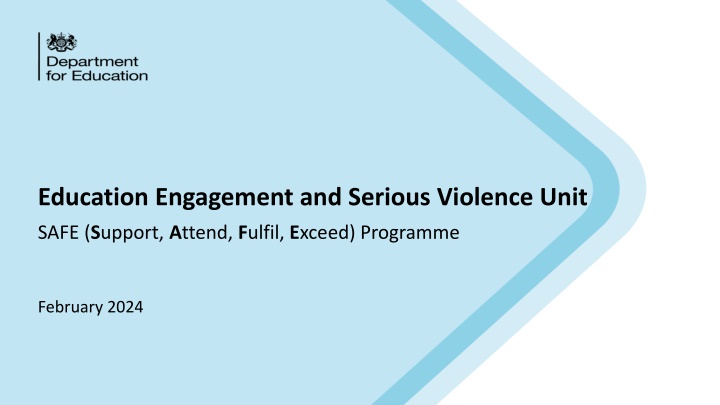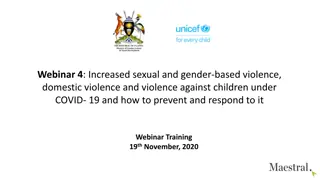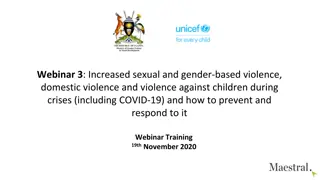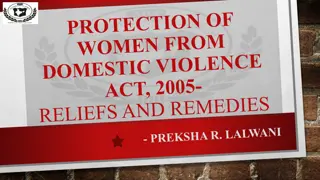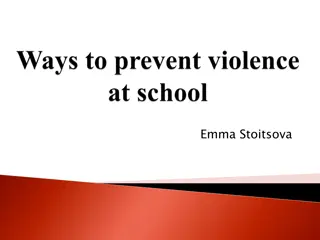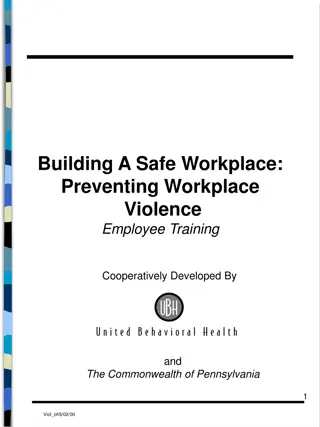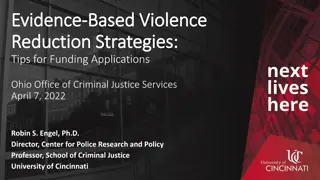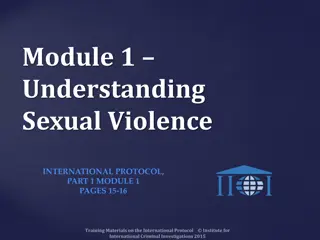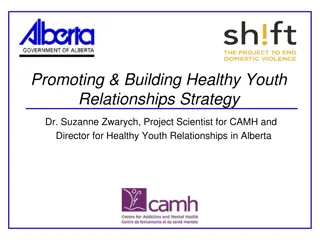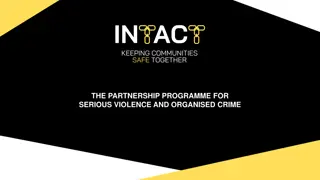SAFE Programme: Enhancing Education and Preventing Serious Violence
The SAFE Programme, implemented by the Education Engagement and Serious Violence Unit, aims to support children at risk of serious violence by setting up taskforces in schools to provide evidence-based interventions. Led by mainstream schools, the taskforces work with local partners to address disengagement from education and reduce vulnerability to violence. The programme focuses on early intervention in secondary schools and funds the recruitment of multi-disciplinary teams to support at-risk pupils. Taskforces commission interventions such as mentoring, social skills training, and cognitive behavioral therapies to improve well-being, school attendance, behavior, and reduce violence involvement.
Download Presentation

Please find below an Image/Link to download the presentation.
The content on the website is provided AS IS for your information and personal use only. It may not be sold, licensed, or shared on other websites without obtaining consent from the author.If you encounter any issues during the download, it is possible that the publisher has removed the file from their server.
You are allowed to download the files provided on this website for personal or commercial use, subject to the condition that they are used lawfully. All files are the property of their respective owners.
The content on the website is provided AS IS for your information and personal use only. It may not be sold, licensed, or shared on other websites without obtaining consent from the author.
E N D
Presentation Transcript
Education Engagement and Serious Violence Unit SAFE (Support, Attend, Fulfil, Exceed) Programme February 2024
Context SAFE Taskforces are one of two DfE programmes testing new ways to support children most at risk of serious violence. SAFE Taskforces SAFE Taskforces Alternative Provision Specialist Taskforces (APST) Alternative Provision Specialist Taskforces (APST) Partnerships led by mainstream secondary schools overseeing a pot of funding to invest in evidence- based interventions. Programme in 10 serious violence hotspots*ending March 25. A specialist workforce model located within AP. Enabling holistic, responsive support to pupils. Pilot programme in 22 schools ending March 25. What APST pilot provides funds to AP schools to recruit multi-disciplinary teams onsite in AP, where children have some of the most acute needs in the education system. The SAFE programme has set up taskforces led by mainstream schools in each areawho work with local partners to plan and commission evidence-based interventions. How This brings together different services across education, youth work, health, justice and social care to work more effectively with those children in Alternative Provision schools, most dis-engaged from education and vulnerable to a range of poor outcomes. The programme is focused on earlier intervention in secondary school (largely focused on children in Y7- Y9) and those dis-engaging from education. 2 * measured using a combination of police offence data and hospital admissions for assault with a sharp object looking at volumes of offences
Set up Taskforces, led by schools, develop a strategic, upstream, school-based response across their LA area for at-risk pupils in mainstream schools. Taskforces may be led by a locally agreed organisation e.g. a Multi-Academy Trust, LA, charity or school improvement company. Example taskforce make up Taskforces identify pupils in years 7 to 9, who have started to disengage from education, and/or are in close proximity to serious violence due to contextual factors. Local Secondary Schools Local Authority VRU representative Alternative Provision Head It is down to the Taskforces to manage their own pots of funding and work alongside other local partners and the experts sitting on the Taskforce to determine how the money is spent in their area, based on DfE guidance. Other education experts SAFE aims to: Improve socio-emotional regulation and well-being Improve school attendance Improve behaviour within schools and the local area Reduce vulnerability to and involvement in serious violence 3
Commissioning Taskforces take local decisions on the evidence-based interventions that they commission for schools in their area. Taskforces have completed a Strategic Needs Assessment and, using this, deliver easily accessible interventions in schools that are relevant to their communities. Local providers do this using innovative approaches to engaging CYP such as outdoor and survival skills in the Peak District as part of social skills training Interventions are informed by the evidence of impact on violence from the YEF Toolkit. All Taskforces were expected to select at least one of the interventions with the strongest evidence-base: Mentoring Social skills training Cognitive behavioural approaches and therapies 4
Monitoring SAFE is undergoing an independent evaluation, but early metrics and feedback provided to DfE is positive. Recently SAFE areas have told DfE that their top 3 successes are: 1. Engagement of children & young people in interventions 2. Better joint working between professionals/local partners 3. Engagement of schools in the programme In November 2023, 39 interventions were in delivery: 14 12 10 SAFE reached over 2100 pupils in AY 22/23 with more interventions ramping up delivery in 23/24. 8 6 4 Analysis of both attendance and fixed term exclusions impact of SAFE showed a small but meaningful improvement in both of those indicators. A qualitative analysis of notes made by the mentors as well as the start of a Voice of the Child study show the impact of mentoring on CYP's confidence, self-regulation, focus in class and improved peer relationships. 2 0 Intervention Type Mentoring Social Skills Cognitive Behavioural Approaches Speech and Language Therapy Other SAFE area feedback to DfE He helps me calm down - breathing techniques and since I started talking to him my behaviour has started to get better. Pupil feedback to an area 5
How is the SAFE programme being How is the SAFE programme being evaluated? evaluated?
Background and approach An independent evaluation of the SAFE programme is being carried out by RAND Europe, FFT Datalab and the University of Westminster. The evaluation was commissioned and is being funded by the Youth Endowment Fund (YEF). The evaluation began in November 2021, with project completion and final reportingdue in 2026. Qualitative and quantitative data is being collected using a range of methods: The SAFE evaluation has 3 workstrands: Focus groups and interviews with schools and local stakeholders A process evaluation to understand the implementation of SAFE for schools, staff, DfE and local areas. Observation of Taskforce meetings Focus groups and interviews with Taskforces An impact evaluation to assess and estimate the impact of the SAFE programme on a range of pupil outcomes Surveys with Taskforces Review of documents and data from DfE and other sources Surveys with headteachers and schools not in a Taskforce A cost evaluation to understand the cost of delivering SAFE for Government and for Taskforces Pupil-level data from the National Pupil Database (NPD) 7
Evaluation workstrands The three workstrands enable us to evaluate the delivery,effectiveness and associated costs of the programme across its lifespan. Understand how the 10 SAFE taskforces were established, their operationalisation, and the implementation of interventions including barriers/facilitators to implementation and mechanisms of change Process evaluation Identify any unintended consequences of Taskforce work and what are the experiences and perceptions of those not involved Inform ongoing feedback and lessons learnt to YEF, DfE and Taskforces Whole programme impact evaluation: Quasi-experimental design (QED) will be used to estimate the impact of the SAFE programme as a whole. QED will be used due to the non-randomisation of areas and of intervention delivery. Impact evaluation Intervention-specific impact evaluation: Ongoing work to understand whether some individual interventions can be evaluated as part of the QED whole programme impact evaluation. Cost Describe the full costs associated with the delivery of SAFE both at the programme level and at the Taskforce level, as well as between area cost variation and the reasons behind this. evaluation 8
Sampling and Outcomes Sampling is being carried out at different organisational levels, and with a range of participants, to help inform the evaluation findings. Outcome Measures Sampling and Data Collection The outcome measures for the impact evaluation include: Taskforce data is being collected from all SAFE taskforces using surveys, focus groups, and interviews. Local Area data is being collected from stakeholders (sampling both SAFE and non- SAFE individuals) to explore local partner agencies and local structures using surveys and interviews. Schools both those which are part of a taskforce and/or delivering an intervention and those schools in SAFE areas which are not part of SAFE delivery. Data is being collected using surveys and interviews. Pupils Unique Pupil Numbers (UPNs) are being collected and will be matched to the NPD. 1. Serious violence offences PNC 2. Hospital admissions for assault with sharp objects NHS digital 3. A&E attendances NHS digital Assault with sharp object All forms of assault 4. Educational outcomes NPD Permanent exclusions Suspensions Absences (including persistent absence) Post-16 participation 9
